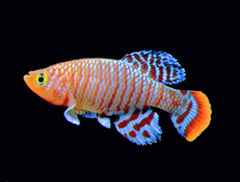
A killifish is any of various oviparous (egg-laying) cyprinodontiform fish,[1] including families Aplocheilidae, Cyprinodontidae, Fundulidae, Nothobranchiidae, Profundulidae, Aphaniidae and Valenciidae. All together, there are 1,270 species of killifish, the biggest family being Rivulidae, containing more than 320 species.[2] As an adaptation to living in ephemeral waters, the eggs of most killifish can survive periods of partial dehydration. Many of the species rely on such a diapause, since the eggs would not survive more than a few weeks if entirely submerged in water. The adults of some species, such as Kryptolebias marmoratus, can additionally survive out of the water for several weeks.[3] Most killies are small fish, from 2.5 to 5 centimetres (1 to 2 in), with the largest species growing to just under 15 centimetres (6 in).
The word killifish is of uncertain origin, but is likely to have come from the Dutch kil for a kill (small stream).[4] Although killifish is sometimes used as an English equivalent to the taxonomical term Cyprinodontidae, some species belonging to that family have their own common names, such as the pupfish and the mummichog.
- ^ Albert, James S.; Tagliacollo, Victor A.; Dagosta, Fernando (2020-11-02). "Diversification of Neotropical Freshwater Fishes". Annual Review of Ecology, Evolution, and Systematics. 51 (1). Annual Reviews: 27–53. doi:10.1146/annurev-ecolsys-011620-031032. ISSN 1543-592X. S2CID 225478064.
- ^ List of Nominal Species of Rivulidae (Rivulines)FishBase. Ed. Rainer Froese and Daniel Pauly. May 2007 version. N.p.: FishBase, 2007. Archived 2007-09-30 at the Wayback Machine
- ^ "Tropical fish can live for months out of water", Reuters, Wed Nov 14, 2007 9:05pm GMT
- ^ van der Sijs, Nicoline (2009). Cookies, Coleslaw and Stoops: The Influence of Dutch on the North American Languages. Amsterdam University Press. p. 198. ISBN 9789089641243.